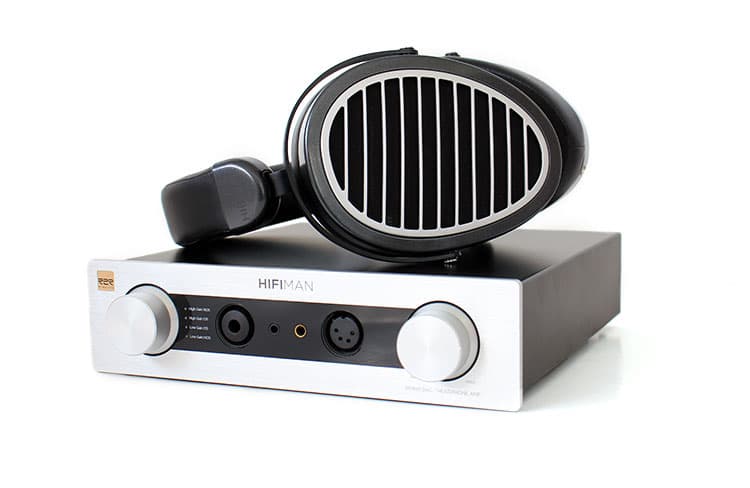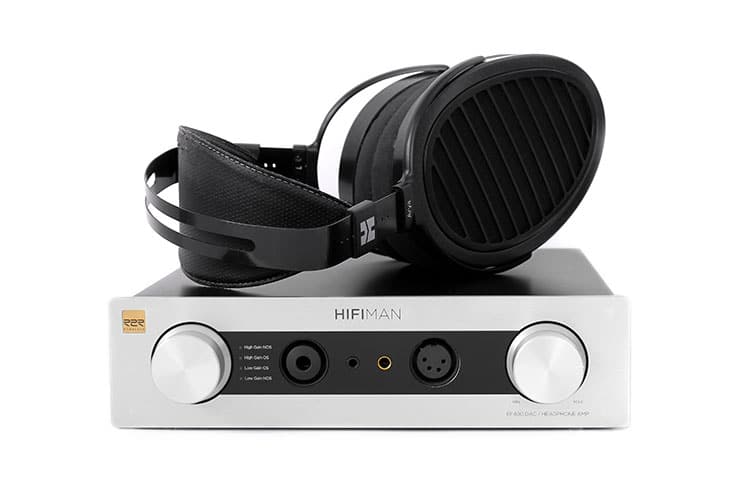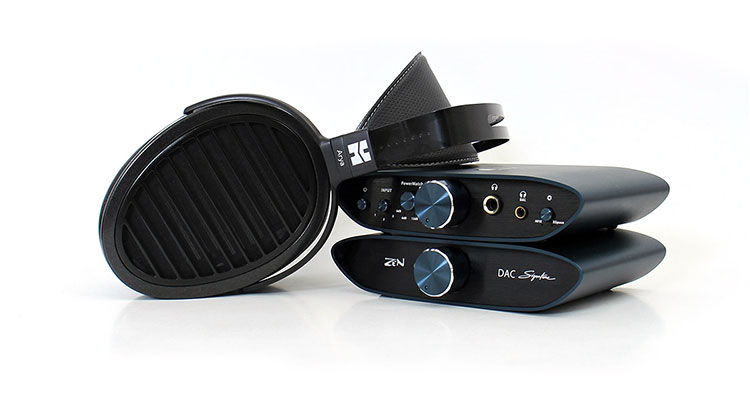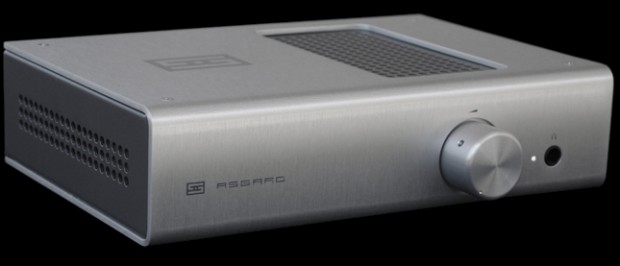Synergy
Efficiency
The EF400 works on 120v and 240v lines and there’s a switch on the bottom of the unit to select the appropriate voltage. Always verify the position of this switch before using the EF400 for the first time and make sure it’s on the appropriate voltage position.
The high current amplifier section within the HIFIMAN EF400 seems to be geared to driving planar magnetic headphones since the high current is what they crave the most to retain dynamics, particularly in those low notes.
The 4.4 watts per channel seem capable of driving my most insensitive cans to painful levels and most cans were content with the low gain setting and at halfway volume if the source gain is set at maximum. IEMs seem well controlled on the lower gain setting and I could almost be certain of noise being absent even on high gain.
Pairings
The HIFIMAN EF400 seems to like warm-sounding headphones and it seems to like the recent stealth magnet designs the most.
However, the OS setting seems to quell the highs some and might be the best setting with most of HIFIMAN’s lineup. But in general, any neutral-sounding headphones will do and you don’t have to stick with the house brand either.
One thing I should say is that using other amplifier sections fed by the Himalaya DAC it leads me to believe that all the sterility sonic qualities are coming from the built-in high current amplifier section. The Himalaya DAC section can truly rise to something special with a high-tier amplifier and shine with natural timbre.
HIFIMAN Sundara Open Back
No doubt this combo makes an excellent pairing since the EF400 brings out the best in them. The vocals especially benefit it seems and that’s the first area you’ll probably notice with this combo. The bass also does well since it seems to bring forth some of the hidden bass response within the Sundara.
Vocals sound airy and crisp, pleasant, and well-balanced overall. Some dislike the Sundara’s upper mid area which I believe to be around the 2kHz region but the EF400 maintains that area well controlled and absent of harshness unless you go savage style with the volume levels.
The power output section seems to give the Sundara enough juice to kick in some low bass increase the impactfulness some have craved from these headphones and give the bass more presence.
HIFIMAN Edition XS
Some Audiophiles use the rule of thumb that if you have a $500 headphone then usually the perfect match for it would be a piece of gear that costs the same. Well, the EF400 makes a great pairing with the Edition XS indeed and they both have very similar costs.
The subtle rise in the bass response of the Edition XS adds that fun factor to this combo I was speaking of earlier with no need for a bass enhancement or a rise in those frequencies. The other aspect that helps the Edition XS play well with the EF400 is its efficiency which is rather high for a HIFIMAN headphone.
The EF400 also brings out the best of the Edition XS high frequencies by giving them height and precise placement within the stage plus a good amount of presence that is crystalline and crisp up on top.
The best aspect however was the height and overall dimensional size of the EF400 staging capability which was the most impressive. There were times that I felt the sound coming from the top of my head and even some rear projecting occurred which, in combination, adds some layers of listening fun.
HIFIMAN Arya
I have the second version which is the more open sounding, the cloth back version that for many is the widest in soundstage and most agree that they’re probably the best version unless you really dig deep bass, then the Stealth version would take first place.
These are the hardest to drive from this group of cans, not so much because of the power requirements but because they deserve gear that is of an upscale level and just like juice. The EF400 and Arya V2 combo works very well but I always felt the Arya could give me more, especially in low-end grunt and visceral impact.
I think the available power is borderline ample but the stage is all there. With the Arya, you get the sense of the macro and micro staging I talked about earlier where for example an instrument like a drummer can sit in a corner and you can clearly distinguish where those sticks are.
Select Comparisons
iFi Audio Zen Signature Set HFM
$599.00
Technical
One of my favorite combos to drive HIFIMAN headphones with out of the box is the iFi Audio Zen Signature Set HFM set which consists of their ZEN Signature DAC V2 and a ZEN CAN Signature HFM in a matching color scheme that is equipped with a HIFIMAN tuned bass boost in place of their Xbass feature.
The 3D feature carries over but power output drops in comparison down to 1,890mW off the balanced side. The ZEN CAN has around three inputs but they’re all analog. The ZEN CAN gets fed an analog signal by the Signature DAC through either RCA or 4.4mm balanced connectivity.
The DAC section uses the 16-core XMOS and custom Burr Brown DACs with a sole USB input and two rear outputs. One is a balanced 4.4mm and the other is with a pair of RCA jacks.
There’s also a variable and fixed switch on the rear panel which makes both output ports either a fixed output or controllable by the volume up front.
Design
You cannot mistake one of these components for someone else’s because the rounded trapezoid retro design is an iFi thing. The outer shells and the front panels are metal with a blue tint and white writing. Both units in this stack are robustly constructed.
Both units are powered by 5 volts DC and come with some iFi iPower 2 adapters which are excellent at providing clean power to both these units.
I do like the fact that iFi constantly revises its firmware versions and you could also choose from a few filters but I do prefer having a switch upfront for that of course. But that’s a set-and-forget operation so once you find a good filter among iFi’s collection then install it and you forget it. I like the GTO filter personally.
Performance
That GTO filter seems to remove sharp edges over the others and sonically that’s why I prefer it. Another cool factoid about the iFi stack is those HFM and Xspace features. They just add an element of fun to the sound signature and a definite cure for cans that are weak at the low end.
That HFM feature especially brings in a cool element and so does the Xspace but that one I rarely use it since most HIFIMAN cans have great imaging. That’s what they’re known for. So why try to fix what’s not broken?
The iFi stack is quite dynamic sounding but it’s a different experience that has a warmish punchy signature. The EF400 tends to maintain a natural tonality in the recording. It doesn’t offer sound alteration and attempts to retain purity.
Schiit Asgard w/optional DAC
$349.00
Technical
I often like to bring into the mix the Schiit audio Asgard because of how much performance you get for such little cash. In reality, it’s a desktop headphone amplifier but you could also buy it with a built-in internal DAC section. My personal unit has a 4490 DAC but nowadays it’s being offered with a brighter-sounding Cirrus Logic 9028.
The Asgard is a desktop headphone amplifier that employs a hybrid amplifier stage design that starts off in class A operation and once the volume reaches a certain level, the amp section kicks into class AB which is more efficient and capable of higher power output levels using the same input voltage rails.
Design
The Asgard is another component that has an old-world appeal as far as ruggedness and the materials used but trust me there’s plenty to indicate there’s a modern-day component here especially when you give it a listen.
The Asgard does give access to the amplifier section since it’s marketed as a headphone amplifier with expandability possibilities. So, you could feed it any DAC with a line-level RCA output since the Asgard lacks a balanced topology. The Asgard is sort of an antithesis to the EF400.
The Asgard has a rather heavy body, a rather thick aluminum front panel with a large volume knob with some rocker-type switches wrapped around. It also has a very thick aluminum skin with perforations for some heat dissipation since it does run a touch warm.
Performance
Speaking of warmth, the Asgard with the 4490 is a big fuzzy ball of warmth, sometimes too warm since micro details are slightly faded. If you feed the amplifier section with the Himalaya DAC it transforms into a formidable beast and a 5 watts per channel class A combo.
That spot-on imaging carries on also if you connect the Himalaya DAC to the RCA line inputs of the Asgard. The sound signature might take a punchier character since technically the Asgard has more raw driving power but seems smeared at high volume levels.
I obtained better results using the balanced output of the EF400 but with the Asgard, I could not tap into the dual 3-pin XLLR analog outputs because the one thing the Asgard lacks is balance topology.
Our Verdict
The HIFIMAN EF4000 is an elegant piece of gear that is simple to use but has a sophisticated sound signature that’s slightly bright tilted, rather neutral, and natural but it punches hard when it has to.
Construction is hefty, to say the least, and you will realize that the first time you hold one physically. The front panel has a balanced-looking design that will look good anywhere you place it and since it doesn’t run hot that spot could be anywhere your USB cable can reach it.
Aside from the lack of being able to access the amplifier section and a lack of features and inputs for that matter, HIFIMAN managed to re-emerge as an excellent desktop component manufacturer and gave us a simple but effective component and another reason to talk about them amongst us enthusiasts.
HIFIMAN EF400 Technical Specifications
- Signal-to-noise ratio: 118 +/- 3db (A-weighted)
- THD-N (line out): between 0.002% and 0.004%
- Channel separation: 125 +/- 3db
- Maximum power output: 4.4w per channel
- Dimensions: 246.5mm x 228mm x 61mm
- Weight: 3.08kg










